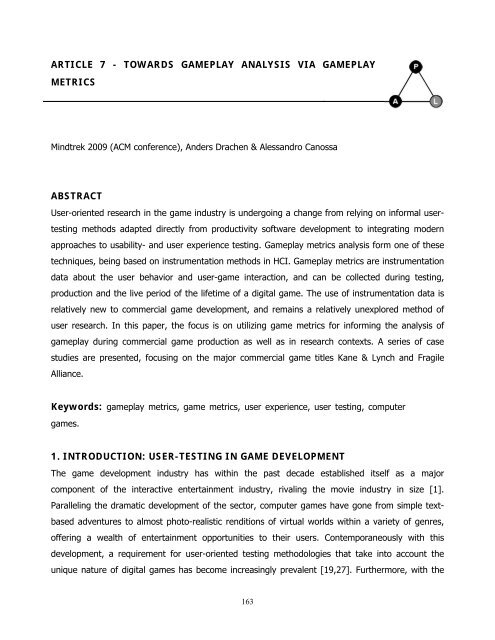Play-Persona: Modeling Player Behaviour in Computer Games
Play-Persona: Modeling Player Behaviour in Computer Games
Play-Persona: Modeling Player Behaviour in Computer Games
Create successful ePaper yourself
Turn your PDF publications into a flip-book with our unique Google optimized e-Paper software.
ARTICLE 7 - TOWARDS GAMEPLAY ANALYSIS VIA GAMEPLAY<br />
METRICS<br />
M<strong>in</strong>dtrek 2009 (ACM conference), Anders Drachen & Alessandro Canossa<br />
ABSTRACT<br />
User-oriented research <strong>in</strong> the game <strong>in</strong>dustry is undergo<strong>in</strong>g a change from rely<strong>in</strong>g on <strong>in</strong>formal user-<br />
test<strong>in</strong>g methods adapted directly from productivity software development to <strong>in</strong>tegrat<strong>in</strong>g modern<br />
approaches to usability- and user experience test<strong>in</strong>g. Gameplay metrics analysis form one of these<br />
techniques, be<strong>in</strong>g based on <strong>in</strong>strumentation methods <strong>in</strong> HCI. Gameplay metrics are <strong>in</strong>strumentation<br />
data about the user behavior and user-game <strong>in</strong>teraction, and can be collected dur<strong>in</strong>g test<strong>in</strong>g,<br />
production and the live period of the lifetime of a digital game. The use of <strong>in</strong>strumentation data is<br />
relatively new to commercial game development, and rema<strong>in</strong>s a relatively unexplored method of<br />
user research. In this paper, the focus is on utiliz<strong>in</strong>g game metrics for <strong>in</strong>form<strong>in</strong>g the analysis of<br />
gameplay dur<strong>in</strong>g commercial game production as well as <strong>in</strong> research contexts. A series of case<br />
studies are presented, focus<strong>in</strong>g on the major commercial game titles Kane & Lynch and Fragile<br />
Alliance.<br />
Keywords: gameplay metrics, game metrics, user experience, user test<strong>in</strong>g, computer<br />
games.<br />
1. INTRODUCTION: USER-TESTING IN GAME DEVELOPMENT<br />
The game development <strong>in</strong>dustry has with<strong>in</strong> the past decade established itself as a major<br />
component of the <strong>in</strong>teractive enterta<strong>in</strong>ment <strong>in</strong>dustry, rival<strong>in</strong>g the movie <strong>in</strong>dustry <strong>in</strong> size [1].<br />
Parallel<strong>in</strong>g the dramatic development of the sector, computer games have gone from simple text-<br />
based adventures to almost photo-realistic renditions of virtual worlds with<strong>in</strong> a variety of genres,<br />
offer<strong>in</strong>g a wealth of enterta<strong>in</strong>ment opportunities to their users. Contemporaneously with this<br />
development, a requirement for user-oriented test<strong>in</strong>g methodologies that take <strong>in</strong>to account the<br />
unique nature of digital games has become <strong>in</strong>creas<strong>in</strong>gly prevalent [19,27]. Furthermore, with the<br />
163















